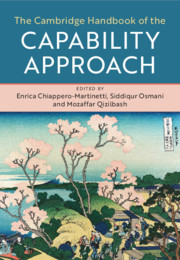Book contents
- The Cambridge Handbook of the Capability Approach
- The Cambridge Handbook of the Capability Approach
- Copyright page
- Dedication
- Contents
- Figures
- Tables
- Contributors
- Foreword
- Acknowledgements
- General Introduction
- Part I Historical Antecedents and Philosophical Debates
- Part II Methods, Measurement and Empirical Evidence
- Part III Issues in Public Policy
- Introduction to Part III
- 25 On Education and Capabilities Expansion
- 26 Capability Approach to Children’s Well-Being and Well-Becoming
- 27 Capability and Disability
- 28 Social Exclusion and Capability Development
- 29 Human Security
- 30 Income Inequality and Human Capabilities
- 31 The Capability Approach and Human Rights
- 32 Capabilities and the Law
- 33 Capabilities, Public Reason and Democratic Deliberation
- 34 Entitlements and Capabilities
- 35 Religion and the Capability Approach
- Index
- References
26 - Capability Approach to Children’s Well-Being and Well-Becoming
from Part III - Issues in Public Policy
Published online by Cambridge University Press: 11 November 2020
- The Cambridge Handbook of the Capability Approach
- The Cambridge Handbook of the Capability Approach
- Copyright page
- Dedication
- Contents
- Figures
- Tables
- Contributors
- Foreword
- Acknowledgements
- General Introduction
- Part I Historical Antecedents and Philosophical Debates
- Part II Methods, Measurement and Empirical Evidence
- Part III Issues in Public Policy
- Introduction to Part III
- 25 On Education and Capabilities Expansion
- 26 Capability Approach to Children’s Well-Being and Well-Becoming
- 27 Capability and Disability
- 28 Social Exclusion and Capability Development
- 29 Human Security
- 30 Income Inequality and Human Capabilities
- 31 The Capability Approach and Human Rights
- 32 Capabilities and the Law
- 33 Capabilities, Public Reason and Democratic Deliberation
- 34 Entitlements and Capabilities
- 35 Religion and the Capability Approach
- Index
- References
Summary
Children’s well-being and well-becoming should be at the centre of policy-makers’ concerns. The deprivation of basic rights and capabilities during childhood not only reduces the well-being of those suffering from such deprivation, but may also have larger implications for achieving justice and prosperity in our societies. A major contribution of the capability approach is that it provides a framework in which children are considered not just as subjects of interventions, but also as active citizens whose priorities, values and aspirations are worthy of recognition.
This chapter, in the first two sections, introduces the debate and the main concepts related to the capability approach towards children’s well-being. The third section presents some of the issues related to children’s agency and participation. The fourth section presents the notion of evolving capabilities, a concept that is especially relevant for children’s capabilities. The fifth section illustrates the synergies existing between children’s rights and the capability approach. The sixth section spells out the main policy implications and the seventh section concludes.
- Type
- Chapter
- Information
- The Cambridge Handbook of the Capability Approach , pp. 523 - 543Publisher: Cambridge University PressPrint publication year: 2020

